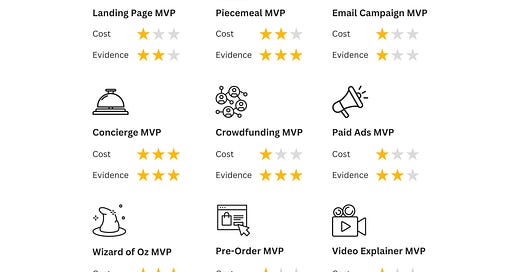What is a Minimum Viable Product? Everything You Need to Know. MVP vs. MMP vs. MLP
What is a Minimum Viable Product? An incorrect understanding of MVP can set you on a path to failure.
Many keep repeating that MVP is “the first usable product version with a minimal set of features.”
I'm sorry. It’s not. Even Wikipedia is wrong.
I don’t like semantic battles. And I know many product managers commonly use the above definition.
But if you employ that approach to assess a new product idea, it's a surefire path to failure.
In Today’s newsletter:
What exactly is a Minimum Viable Product?
Case study: DropBox Video Explainer MVP
🔒 MVP prototypes every PM should know
🔒 MVP prototype vs. MMP vs. MLP
🔒 Practical tips & insights (e.g., MVP as a process)
1. What exactly is a Minimum Viable Product?
The word “Product” is causing a lot of confusion.
The goal of a Minumum Viable Product (MVP for short), as defined by Eric Ries in The Lean Startup, is to validate key assumptions about the product idea and get maximum validated learning with minimal effort.
The value of MVP is to learn as quickly as possible, minimize risk and increase your chances of success by experimenting.
Creating value for customers is not the goal.
This is because creating products, e.g., writing software, is one of the most expensive ways to verify your hypotheses. If the assumptions were wrong, the work performed over many iterations could be wasteful.
In contrast, building the first MVP should typically take a few hours or days. An order of magnitude cheaper and faster.
1.1 Explanation you might want to skip
As Marty Cagan explains in chapter 8 of Inspired:
“The MVP should be a prototype, not a product”
In Value Proposition Design, Alexander Osterwalder defines MVP as:
"A representation or prototype of a value proposition designed specifically to test the validity of one or more hypotheses/assumptions (...) The goal is to do so as quickly, cheaply, and efficiently as possible."
This is also supported by Roman Pichler. Let me quote his article:
"As lack of knowledge, uncertainty, and risk are closely related, you can view the MVP as a risk reduction tool."
It doesn’t help that Eric Ries used the term that existed before and uses it inconsistently. For example, he says MVP is a product, at the same time using a landing page as an example.
No wonder people feel confused!
1.2 Recommended solution
In the Lean Product Playbook, Dan Olsen proposed the term MVP prototype.
In my opinion, that’s a great way to avoid semantic battles and focus on what matters - learning as quickly and cheaply as possible.
Another approach is using the term Pretotype from The Right It and Pretotype It by Alberto Savoia. Both books are fantastic.
2. Case study: DropBox Video Explainer MVP
An example that always inspires me is a DropBox Video Explainer MVP:
At that time, DropBox didn’t have a product. Instead, they created a simple video for a community of early adopters to demonstrate how the solution is meant to work.
As a result, their beta waiting list went from 5,000 to 75,000 people overnight.
At Startup Lessons Learned 2010, Drew Houston summarized his learnings with this slide:
3. MVP prototypes every PM should know
Here are 9 of the most common MVP types every product manager should know:
Keep reading with a 7-day free trial
Subscribe to The Product Compass to keep reading this post and get 7 days of free access to the full post archives.





